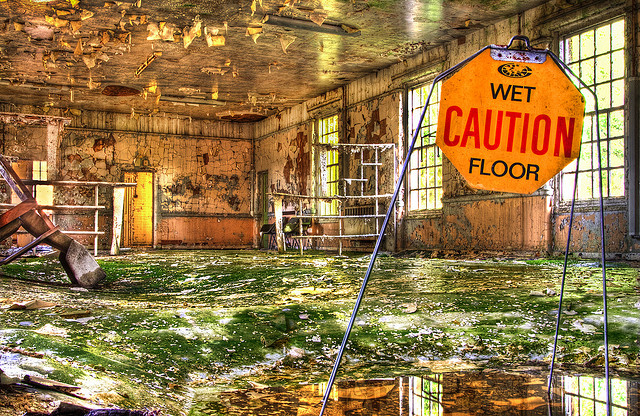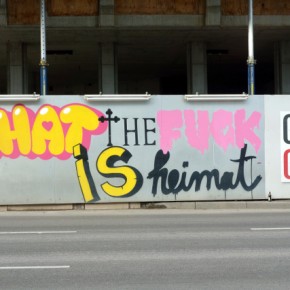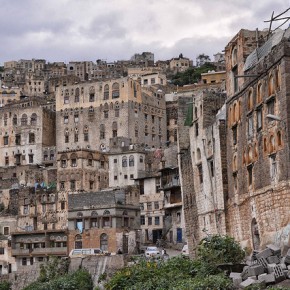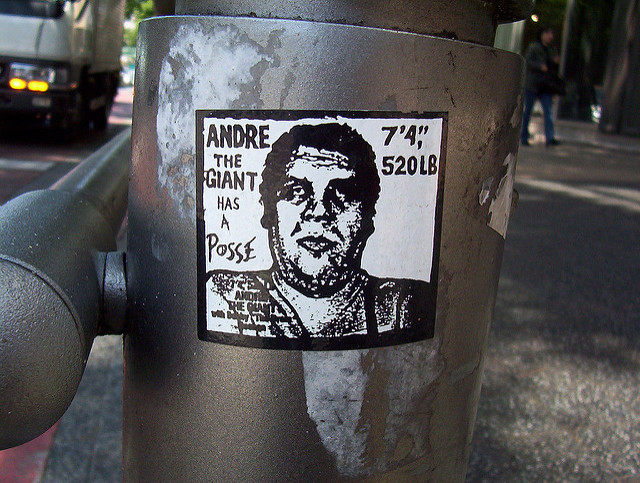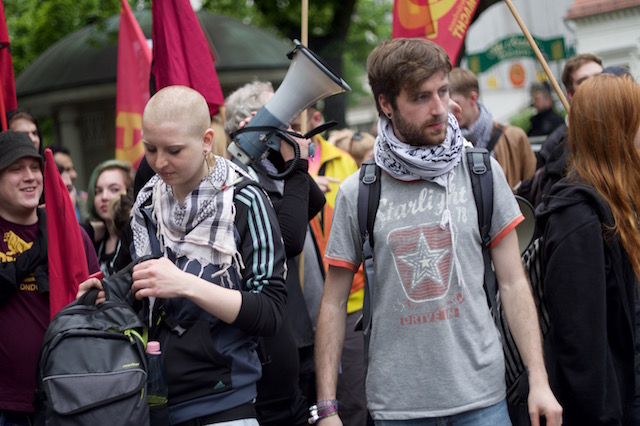In the fall of 1992, I moved to New York to attend the New School for Social Research. Separated from my social scene in Portland, Oregon and with little money, I spent my first weeks in Manhattan feeling very much out of sorts. It was then that I reconnected with an old friend from my undergraduate days. Donny was going to Cornell Medical School uptown. He’d grown up in and around the city, and he made it his business to help me acclimate.
And so it was that I found myself in the wee hours of a muggy September night bopping down Delancy Street on the way to the west approach of the Williamsburg Bridge. Hours before, Donny and I had been sitting in a bar in the village when he’d mooted the idea of climbing to the top of the bridge tower. The idea scared the crap out of me, but mostly because I’m afraid of heights. Having spent my teenage years in the hardcore punk scene, hanging out in squats, anarchist gatherings, and even the occasional riot, the idea didn’t seem outside of the norm. But the thought of climbing 135 feet did cause me a great deal of trepidation. It was only alcohol and wounded manhood the prompted me to agree.
The climb itself was pretty simple. We walked along the pedestrian path until we were underneath the west tower. It was bordered by a black, wrought iron railing. Beyond it was a utility platform and a set of narrow metal stairs separated from the railing by a gap of three or four feet above the car deck. I had a moment of hesitation as I considered that the failure to get across meant almost certain death. But Donny made the jump without hesitation. I clenched my teeth and followed.
We sprinted up innumerable flights of stairs, tracking back and forth along the superstructure of the tower. After five minutes or so we reached a square catwalk at the top, only a couple of feet wide and bounded on both sides by a single iron rail. I clutched it so hard that I thought my fingers would leave impressions on it. Donny, by contrast, had been up several times before and seemed very much at ease. He point out the sights of the city to me: the lights of Williamsburg, the skyscrapers of midtown Manhattan, and far away to the south the Verrazano Narrows Bridge connecting Brooklyn to Staten Island. It was, for me, simultaneously one of the most beautiful and terrifying moments of my entire life.
Over the following weeks and months Donny continued to show me the sights of the city from the tops of buildings and the backs of moving subway cars. We returned to the bridge walk on several occasions, and the experience never lost its edge. You never knew who you would meet up there. Usually it was just taggers, who weren’t really dangerous, just irritated that you had interrupted their work. The fact of the matter was that no one up there wanted any trouble, since any kind of police response was likely to have very unfortunate consequences.
There was a ladder that extended up from the catwalk to a trapdoor and a compartment above. Donny suggested that we climb it, but I didn’t have the guts. Donny told me the story of some people he knew who had decided to have a picnic in the compartment. Everything was going great until a cop poked his head through the door and demanded that they come down with him. When they got to the bottom, they discovered that someone had reported them. They’d been mistaken for some sort of suicide cult and the cops had blocked off traffic on the bridge in both directions just in case. That was the kind of thing you definitely wanted to avoid.
I was reminded of these nocturnal exploits by two recently published accounts of the urban exploration movement: Moses Gates’ Hidden Cities and Bradley Garrett’s Explore Everything. Urban exploration (sometimes shortened to urbex or simply UE) is a version of something that must be as old as cities themselves, i.e. the desire to have a look at places made inaccessible by the structures, both physical and legal, of the built environment. In its modern form, as a self-conscious cultural practice, it has roots in the late 1980s and early 1990s, although the precise moment at which it evolved from the simple exercise of curiosity to a goal oriented activity undertaken in groups is impossible to pinpoint. What is clear is that by the late 1990s/early 00s, a self-conscious culture of exploration had arisen, complete with its own fan literature, named figures, and crews.

Urban exploration is difficult to talk about in comprehensive terms. It is one of a range of polycephalous, autonomist cultural formations comprising the intersection of other such entities such as hardcore punk, graffiti writing, skateboarding, and squatting, but extending also into the realm of cultural studies. It is most effectively talked about via major figures whose work, both in terms of exploration and self-documentation both define the limits and open up new possibilities for the broader scene.
One such figure was the Toronto-based urban explorer Jeff Chapman, better known by his handle, Ninjalicious. Before his death from cancer in 2005, Chapman had not only engaged in extensive exploratory activities, he had also documented them extensively via his zine, Infiltration, probably the most internationally prominent publication in the UE scene. At the time of his death he had just finished work on a book, Access All Areas, comprising the range of knowledge and techniques that he had acquired. It has something approaching biblical status in the urban exploration community, although it’s illustrative of the anarchic nature of the scene that most major players only read Chapman’s book after they were well along in their own explorations.
Although UE lacks an all encompassing ideology or ethic, there are some patterns that can be discerned, and the above-mentioned books by Gates and Garrett illustrate some of the most important of these. Gates’s book takes the form of a memoir, detailing the growth of his love for exploring cities into a fascination, sometimes bordering on obsession, with exploring places he was not permitted to be. Hidden Cities narrates the exploits of Gates and his exploring partner Steve Duncan, ranging from the bridges and tunnels of New York, to the catacombs of Paris, to the sewers of Rome, Moscow, and beyond. Gates’ voice is subtle and self-effacing as he explains his motivations for exploring and the ethic that he developed while doing so. His is the unpretentious narrative of the main line UE practitioner, the sort who has fallen into exploration out of pure curiosity and an interest in getting to know the city on a more intimate basis than its run of the mill denizens.
Garrett, by contrast, was already doing graduate work (in social or cultural anthropology if his references are anything to go by) when he became involved in the urban exploration scene in London. His book has rather a different flavor, framing the narrative of his explorations with the London Consolidation Crew with meditations on the philosophical aspects of UE touching on figures from Guy Debord and Raoul Vaneigem, to Maurice Merleau-Ponty, along with a range of more modern cultural anthropologists and sociologists. Where Hidden Cities focuses more on Gates’ personal development,

Explore Everything devotes more time to the interaction between various crews and the way the UE functions as an expression of both individual and collective ideals.mBut what are they? This is the central question. Both Gates and Garrett discuss their actions in non-sectarian, libertarian terms. They seem to have a critical agenda: the destabilization of the repressive control of neo-liberalized urban space. And both demonstrate a persistent interest in learning about the cycles of (predominantly but not solely) growth and decay, using abandoned places as a dialectical negation of neo-liberal urbanism. But it never goes much further than that. A coherent, critical ideology is consistently absent.
Garrett comes closer than Gates to addressing this problem. At one point he concedes that, “[t]he urban exploration community deserves to be problematised for its lack of sociopolitical contextualization or self reflection, or for the failure on the part of individual participants to interrogate their own desires to capture, collect, protect and control information and locations, in contrast to the open-source ethic they espouse.”
While cognizant of this fact, even in terms of his own thinking on the topic, Garrett’s critical apparatus seems only to address the immediate nexus of the explorer with the built environment and its power dynamics. His thinking is much like that of Lyotard in The Postmodern Condition. The grand narratives of political criticism are rejected (in Garrett’s case entirely ignored) in favor of a free play that destabilizes systems of power by illustrating their limits and possibilities of action beyond constraint. For Garrett, UE is a sort of propaganda of the deed, building solidarity through intense experiences in common, a phenomenon that Garrett terms “the meld.”
At certain points, Garrett alludes to the fact that his participation in this scene was part of his doctoral thesis project. Although accepted by his comrades, there is also a clear recognition of this fact, with one of them even noting that Garrett had, in a certain sense, created a cultural event and then written about it. This is by no means to credit Garrett with creating UE, in general. But it is an oddly engaged sort of cultural anthropology. It’s as if Bronislaw Malinowski taught New Guinea tribesmen to play basketball and then created a league circuit based on the Kula ring.
Gates, by contrast, related to the UE scene more organically, becoming an urban explorer in a way that was both a cause and a result of the collapse of his life in “normal” channels. Gates actually appears in Garrett’s book on several occasions, evincing a moderate and unpretentious attitude toward exploration that seems at odds with the approach of the LCC.
Gates and Garrett succeed in illuminating the inner workings of the UE scene in ways that correct for the distortions of media hype. Taken together, Hidden Cities and Explore Everything do important work in showing ways that people have challenged the spaciopolitical order of neoliberalism. This challenge is (or can be) one of the most crucial in the developed world, as the prominence of the various instantiations of the Occupy movement illustrated.
Yet the lack of a more coherent and comprehensive politics makes it difficult for urban explorers to address the extension of repressive, systemic power on anything but an ad hoc basis. The scene further suffers from its status as a practice for virtuosi rather than the laity. Solidarities among UE practitioners and crews is fragile and fleeting. The extension of urban exploration as an ethic fit for general consumption involves a fallacy of composition. For example, for if all sought self-realization through these means, the very commonality of the action would close it off as an avenue (imagine 200 people all trying to free climb the Williamsburg Bridge at once.) Additionally, the self-promotion (via websites, blogs, books, and other means) that is so central to the UE community means that it is itself increasingly susceptible to domestication and appropriation by the systems of power that its practitioners seek to challenge.
Still, there is something beautiful and human about the work of both Gates and Garrett. Both are engaged in projects of human liberation, expressions of freedom thrown in the face of the constraining powers of the city. If it’d the case that neither has discovered a universal ethic, they have certainly discovered and documented practices that can, at certain times and places, constitute models for a freer human existence.
Photographs courtesy of Ashley Burton Fougerouse Arnaud, and Tunnel Bug. Published under a Creative Commons license.
